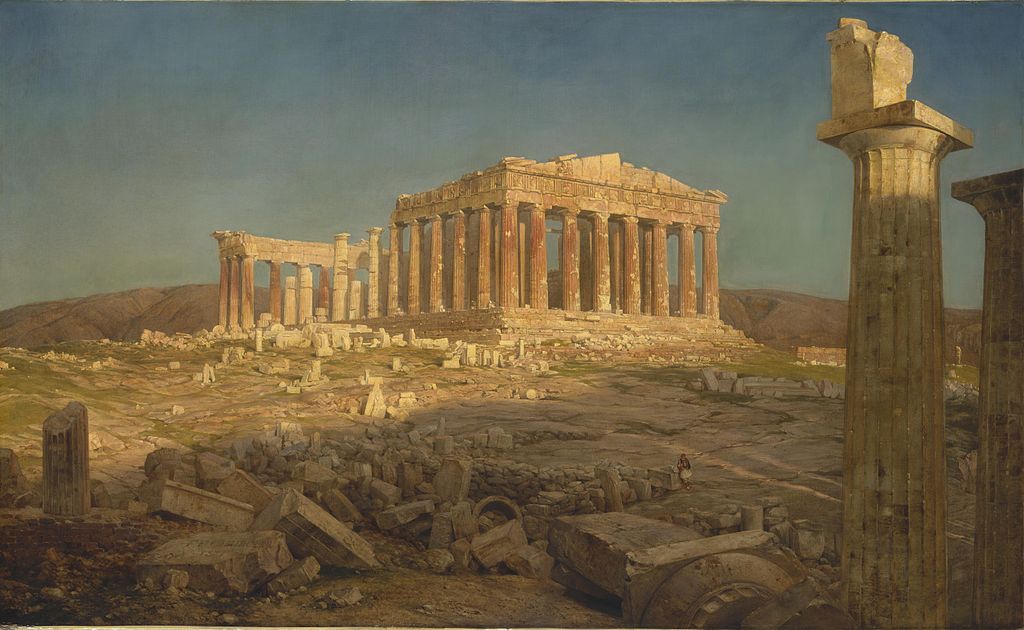
“The Parthenon” by Frederic Edwin Church is a large 1871 painting of the Parthenon. The Parthenon was built on the Acropolis of Athens, Greece, between 447 and 432 B.C.
This painting was made after it had suffered its worst damage in 1687 when a Turkish gunpowder magazine located within the Temple exploded after a direct hit by the Venetian besieging army.
It also reflects the scene after the removal of many of its surviving sculptures between 1800 to 1803 by Lord Elgin, who sold them to the British Museum.
The American artist, Church, visited Greece in 1869 and spent several weeks in Athens, where he made numerous studies of the ruins of the Parthenon that later served as the basis for this 1871 work.
The Parthenon
The Parthenon is an enduring symbol of Ancient Greece and one of the world’s most significant cultural monuments.
The Parthenon was a temple dedicated to the goddess Athena and was constructed over 2,500 years ago when the state of Athens was at the peak of its power.
The Athenians built the Parthenon as a celebration of their pan-Hellenic victory over the Persian invaders. It was also a thanksgiving to the gods for that victory.
The Parthenon replaced an older temple of Athena that was destroyed by the Persian in 480 BC.
Following the first destruction of the Acropolis by the Roman invasion of Athens, when successive Roman generals looted the Parthenon, it later became incorporated into the Byzantine Empire when the Parthenon was converted into a Christian church dedicated to the Virgin Mary.
After the Ottoman invasion and conquest, the Parthenon was turned into a mosque in the early 1460s. Later in 1687, as an Ottoman ammunition dump, the building was exploded by Venetian bombardment.
The resulting explosion severely damaged the Parthenon and its sculptures. From 1800 to 1803, Lord Elgin removed many of the surviving sculptures, which were sold in 1816 to the British Museum in London, where they are now displayed.
Today the Parthenon looks on battle scared but resolute with an amazing and inspiring survival story.
Frederic Edwin Church
Frederic Edwin Church (1826 – 1900) was an American landscape painter who was a central figure in the Hudson River School of American landscape painters.
He is best known for painting large landscapes, often depicting mountains, waterfalls, and sunsets. Church’s paintings emphasized realistic detail, dramatic light, and panoramic views. During his time, he was one of the most famous painters in the United States.
The Parthenon
- Title: The Parthenon
- Artist: Frederic Edwin Church
- Year: 1871
- Medium: Oil on canvas
- Dimensions: 113 x 184.5 cm
- Museum: Metropolitan Museum of Art – MET
Frederic Edwin Church
- Artist: Frederic Edwin Church
- Born: 1826 – Hartford, Connecticut, United States
- Died: April 7, 1900 (aged 73) – New York City, New York, United States
- Nationality: American
- Movement: Hudson River School
- Notable Works:
- The Parthenon
- The Aegean Sea
- Niagara
Parthenon on the Acropolis
Explore The Parthenon
- The Parthenon Frieze
- Metopes of the Parthenon
- Pedimental Sculptures of the Parthenon
- The Parthenon Marbles
- The Parthenon
- The Erechtheion
- The Porch of the Caryatids
The Acropolis and The Parthenon
MET European Paintings Collection
- “Pygmalion and Galatea” by Jean-Léon
- “Saint Jerome as Scholar” by El Greco
- “Portrait of Juan de Pareja” by Diego Velázquez
- “Camille Monet on a Garden Bench” by Claude Monet
- “View of Toledo” by El Greco
- “The Musicians” by Caravaggio
- “The Death of Socrates” by Jacques-Louis David
- “The Harvesters” by Pieter Bruegel the Elder
- “Young Woman Drawing” by Marie-Denise Villers
- “The Grand Canal, Venice” by J. M. W. Turner
- “The Houses of Parliament (Effect of Fog)” by Claude Monet
- “Madame Cézanne in a Red Dress” by Paul Cézanne
- “The Fortune Teller” by Georges de La Tour
Secrets of the Acropolis
MET Modern and Contemporary Art Collection
- “Reclining Nude” by Amedeo Modigliani
- “Improvisation 27 (Garden of Love II)” by Wassily Kandinsky
- “Jeanne Hébuterne” by Amedeo Modigliani
- “The Card Players” by Paul Cézanne
- “Bathers” by Paul Cézanne
MET American Wing Collection
- “Washington Crossing the Delaware” by Emanuel Leutze
- “Portrait of Madame X” by John Singer Sargent
- “Mother and Child” by Mary Cassatt
- “Fur Traders Descending the Missouri” by George Caleb Bingham
- “The Gulf Stream” by Winslow Homer
- “The Parthenon” by Frederic Edwin Church
- “The Aegean Sea” by Frederic Edwin Church
Parthenon Battle
~~~
“Earth proudly wears the Parthenon
As the best gem upon her zone.”
– Ralph Waldo Emerson
~~~
Photo Credit: 1)Frederic Edwin Church [Public domain]
Popular this Week







 Sponsor your Favorite Page
Sponsor your Favorite Page SEARCH Search for: Search Follow UsJoin – The JOM Membership Program
Sponsor a Masterpiece with YOUR NAME CHOICE for $5
Share this:
- Tweet
